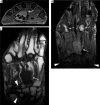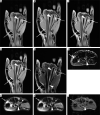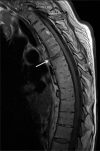Magnetic resonance imaging of rheumatological diseases
- PMID: 35280946
- PMCID: PMC8906181
- DOI: 10.5114/pjr.2022.113390
Magnetic resonance imaging of rheumatological diseases
Abstract
Magnetic resonance imaging (MRI) is extremely useful in the early diagnosis of rheumatologic diseases, as well as in the monitoring of treatment response and disease progression to optimize long-term clinical outcomes. MRI is highly sensitive and specific in detecting the common findings in rheumatologic diseases, such as bone marrow oedema, cartilage disruption, articular erosions, joint effusions, bursal effusions, tendon sheath effusions, and synovitis. This imaging modality can demonstrate structural changes of cartilage and bone destruction years earlier than radiographs. Rheumatoid arthritis, crystal deposition diseases (including gouty arthropathy and calcium pyrophosphate deposition disease), seronegative spondyloarthropathies (including psoriatic arthritis, reactive arthritis, ankylosing spondylitis), and osteoarthritis have characteristic appearances on MRI. Contrast-enhanced MRI and diffusion-weighted imaging can provide additional evaluation of active synovitis. This article describes the MRI findings of normal joints, as well as the pathophysiological mechanisms and typical MRI findings of rheumatoid arthritis, gouty arthritis, calcium pyrophosphate deposition disease, psoriatic arthritis, reactive arthritis, ankylosing spondylitis, and osteoarthritis.
Keywords: MRI; ankylosing spondylitis; calcium pyrophosphate dihydrate deposition; gout; psoriatic arthritis; rheumatoid arthritis.
© Pol J Radiol 2022.
Conflict of interest statement
The authors declare that they have no conflict of interest.
Figures























References
-
- Rubin DA. MR and ultrasound of the hands and wrists in rheumatoid arthritis. Part II. Added clinical value. Skeletal Radiol 2019; 48: 837-857. - PubMed
-
- Sudoł-Szopińska I, Jurik AG, Eshed I, et al. . Recommendations of the ESSR Arthritis Subcommittee for the Use of Magnetic Resonance Imaging in Musculoskeletal Rheumatic Diseases. Semin Musculoskelet Radiol 2015; 19: 396-411. - PubMed
-
- Shiraishi M, Fukuda T, Igarashi T, et al. . Differentiating Rheumatoid and Psoriatic Arthritis of the Hand: Multimodality Imaging Characteristics. Radiographics 2020; 40: 1339-1354. - PubMed
-
- Chang EY, Chen KC, Huang BK, Kavanaugh A. Adult Inflammatory Arthritides: What the Radiologist Should Know. Radiographics 2016; 36: 1849-1870. - PubMed
-
- Stomp W, Krabben A, van der Heijde D, et al. . Aiming for a simpler early arthritis MRI protocol: can Gd contrast administration be eliminated? Eur Radiol 2015; 25:;1520-1527. - PubMed
Publication types
LinkOut - more resources
Full Text Sources
Research Materials
